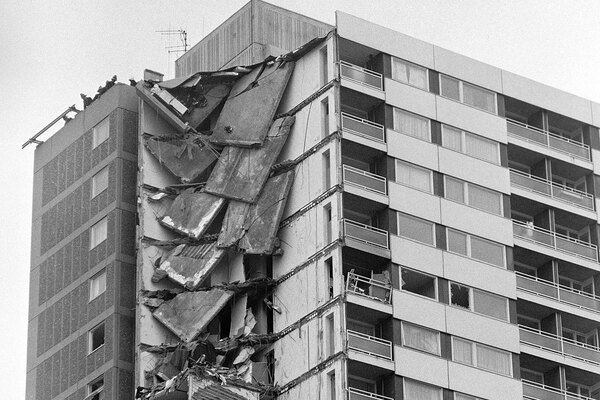Fear and loathing
Anti-social behaviour can blight people’s lives and destroy neighbourhoods. Caroline Thorpe speaks to victims and housing professionals to discover how social landlords are contributing to the national fight against troublemakers to improve community life

George Adams has lived in the same house for 44 years. For the past 10 of them, anti-social behaviour has made his life hell.
The pensioner’s ordeal began for him and his family a decade ago, when the couple living next door in what was then a Liverpool council house began a campaign of what Mr Adams calls ‘harassment beyond belief’. What followed was an onslaught of vile language, false accusations and threats, even to his family’s lives.
Mr Adams and his family weren’t the only ones to suffer. Another neighbour in their Merseyside close has called the experience ‘a living hell’. Yet another has described how ‘the fear is always there, 24 hours a day, seven days a week’.
But this January, the long-suffering residents finally reached the moment they’d long hoped for. Liverpool Civil Court gave social landlord Riverside, now owner of the property from which the sustained harassment and abuse was conducted, the go-ahead to evict perpetrators Mr and Mrs Ioannou. The court also banned the couple from returning to the close and its adjoining road. On 19 February this year, the pair left the area for the last time.
‘It’s a dramatic change,’ says Mr Adams, who doesn’t want to give his real name, or details which might reveal his identity for fear of retribution from his former tormenters.’It’s the first time in 10 years I’ve felt I’ve been able to go out in the garden and enjoy it… without fear of harassment.’
Mr Adams had not suffered in silence. From the onset of the Ioannous’ reign of terror, he kept diaries of their anti-social behaviour which he presented to the city council. ‘I didn’t get an awful lot of response, I must confess,’ he says. His efforts to interest the police made similarly little headway. The harassment continued.
Landlord involvement
How, then, did Mr Adams and his long-suffering neighbours finally come to see the back of their harassers? The answer: the intervention of a social landlord.
‘Some two or three years ago, thankfully, [Riverside] took a great interest and they were going for eviction,’ says Mr Adams. He explains how two Riverside staff in particular - tenant relations officer Marion Parker and director Tom McGuire - painstakingly collated the evidence Mr Adams had gathered over the years, and trawled the archives for police case notes dating back to when the Ioannous’ behaviour began.
‘They helped and supported in many ways,’ he adds. Though he reckons his own perseverance would have seen the couple evicted eventually, he admits that without Riverside’s efforts ‘it would have taken longer’.
The Riverside case is just one of many daily examples of social landlords intervening to transform people’s quality of life by tackling anti-social behaviour. Landlords are busy investing, training, partnering, educating and innovating all with the simple aim of clamping down on anti-social behaviour - from extreme harassment, to noisy neighbours, to low level nuisance like graffiti and litter.
In this, the penultimate instalment of Inside Housing’s and the Chartered Institute of Housing’s House Proud campaign, which makes the case for continued investment in housing, we demonstrate the massive difference such initiatives are making to people’s lives with a taster of the array of initiatives landlords offer. More than this, we explain why housing providers are proving such effective weapons in the national drive to clamp down on nuisance behaviour, and how their efforts are being rewarded by growing recognition of their role at the forefront of tackling ASB.
National influence
Officially, the police are in charge of the national fight against anti-social behaviour which achieved prominence in 2005 through former prime minister Tony Blair’s ‘respect’ agenda. But, according to Her Majesty’s Chief Inspector of Constabulary, they’re not doing a very good job. ‘Police systems vary in their ability to identify repeat [ASB] victims and vulnerable victims,’ Denis O’Connor remarked in a speech last month.
In contrast, social landlords’ ASB work is gaining recognition. Prime minister Gordon Brown is among those championing their efforts. In a recent interview with Inside Housing, Mr Brown spoke of plans for new guidance on ASB ‘to equip more landlords to reach the standards of the best’ (Inside Housing, 9 April).
Experts agree that landlords’ ASB work is becoming more important. ‘They’re more evident in their work,’ says Mark Connolly, group manager at Action for Children, the charity which helped to pioneer family intervention projects which have won acclaim for supporting disruptive families.
Mr Connolly runs FIPs in the Greater Manchester area and reckons he is helping around 100 families at any one time. ‘All work to some extent with social landlords,’ he says, adding that a couple actually supply projects with core residential units. ‘By the nature of their work, [social landlords] have an understanding of the needs of families.’
Another reason why landlords are so effective at handling nuisance behaviour is the plethora of powers available to them. Although both the police and schools can use many of them, former Metropolitan police officer Trevor Kennett explains that housing providers are often best placed to deploy them: ‘The reality is that [housing associations] manage a lot of the social housing stock in the UK.
Mr Kennett, who now runs Safety Net Associates which specialises in ASB training for housing staff, adds: ‘As an association they have some additional powers, such as breach of tenancy. The latter means that as a last resort landlords can evict troublesome tenants, such as the Ioannous.’
Crucially, though, landlords can address anti-social behaviour without turning to such extreme measures. ‘What people forget about [landlords] and ASB is that good housing management works. Housing officers know their tenants, can talk to them. Very early on there’s an intervention,’ says Mr Kennett.
Getting results
This kind of prevention work is what Michael Redford, deputy managing director of neighbourhoods at Irwell Valley, calls ‘nipping it in the bud’. Based in Greater Manchester, the 7,000-home association spends around £250,000 a year tackling ASB. It’s money well spent. ‘The vast majority is nipped in the bud,’ confirms Mr Redford.
‘It can escalate, but 95 per cent of ASB is low level and we deal with it through early intervention.’ This could include ‘diversionary’ tactics to keep young people occupied - a BMX track set up with the YMCA is one example - to simply making sure the landlord is delivering what residents want. ‘They are basically looking for a clean space and a green neighbourhood.’
The results of Irwell Valley’s approach speak for themselves. A combination of actions in one problematic neighbourhood led to a 14 per cent drop in resident turnover, a £32,000 cut in re-let costs and a 60 per cent reduction in rent loss from void properties.
And landlords are maximising the benefits of such techniques by teaming up with other ASB-busting agencies. Indeed, at stock-owning councils the housing department often leads. Suffolk’s Barbergh Council housing staff, for example, ‘have the main responsibility for tackling ASB… and will work in partnership with other services’.
‘What’s important is that [housing providers] and the councils and the police all work together,’ advises Mr Kennett. ‘Between them, they can absolutely protect the public.’
Certainly Mr Adams would not be enjoying the spring sunshine in his garden without Riverside’s ability to connect the dots between agencies.
‘At my time of life, why should I sell up and move on?’ he asks. ‘I’m set here. I’m set in my ways and, you know, you get the house how you want it. I’m not going to move for anyone.’
The CIH says
There is growing public expectation in relation to the role social landlords play in addressing anti-social behaviour and many excellent examples exist where social landlords are working closely with partners and residents to effectively tackle the cause and effect of anti-social behaviour within communities.
Evidence shows that actions taken by housing officers are successful in resolving more than 75 per cent of reported anti-social behaviour cases. However, not all landlords are as confident in delivering the full range of anti-social behaviour services available to them. More help is needed and we are pleased that a new team of national advisors, based with the Chartered Institute of Housing, will help drive forward improvements within the sector and support landlords to improve anti-social behaviour services delivered to residents.
Sarah Webb is chief executive of the Chartered Institute of Housing
Bite-size case studies
What Anti-social behaviour action team
Who Chartered Institute of Housing. Three (soon to be four) expert advisors offer free support to housing providers wanting to reduce ASB, strengthen community cohesion and bring about lasting change for tenants.
What Resident inspectors
Who Stevenage Homes. Last month Stevenage Homes tenants and experienced resident inspectors Bill Whelan and Michael Hearn received accreditation (official backing) from Hertfordshire Constabulary to tackle ASB, including graffiti, litter and underage drinking.
‘We talk to a lot of people and see a lot of what goes on on estates,’ says Mr Whelan. ‘[Accreditation] seemed like an ideal way to develop our role and to help to keep the communities in which we work safe and pleasant.’
What New children’s centre used as police base
Who Amber Valley Housing and Derbyshire Council. The partners got together to turn a disused meeting room in a sheltered housing complex into a children’s centre. Local residents were keen for the new facility to offer a police presence to help tackle local ASB. The partners made it happen. As well as offering early education, family support and health advice, the centre has improved local resident safety and reduced the risk of neighbourhood ASB.
What Southend multi-agency anti-social behaviour response team
Who South Essex Homes, Southend Police and Southend-on-Sea Council. Arm’s-length management organisation South Essex Homes seconds two of its staff to SMAART which provides a co-ordinated approach to tackling nuisance behaviour in the Essex borough. The initiative is just one aspect of the ALMO’s ASB work, which this year gained formal accreditation from Housemark and the Social Landlords Crime and Nuisance Group for its ‘high quality anti-social behaviour service’.
House Proud statistics: anti-social behaviour
Four in five repeated ASB sufferers across England and Wales say ASB is having a ‘high impact’ on their quality of life. *
Early intervention by social landlords resolves almost 75 per cent of the ASB they record. **
A third of families in family intervention projects were referred there by housing professionals, which resulted in a 46 per cent increase in families not involved in ASB ***
£235,000 - minimum saving to taxpayer for every ‘anti-social’ family helped through a family intervention project ****
Sources: * HM Inspectorate of Constabulary repeat victim survey, January 2010. **Housemark 2008/09. ***Department for Children, Schools and Families, November 2009. ****Communities and Local Government department, 2006.
House Proud: how to get involved with the campaign
- Sign our online petition in support of our three aims to gain 250 backers at www.insidehousing.co.uk/houseproud, get housing pledges into the manifestos of the three main political parties and get the sector to talk up housing as a key election issue
- Persuade the main political parties to include the House Proud pledge on funding mass retrofit in their election manifestos
- Pledge to drop House Proud statistics into as many conversations as possible
- Ask prospective MPs what they’re doing about housing and persuade them to sign the House Proud petition
- Send your stories, videos, blogs and statistics about how housing has proved its worth in your area








